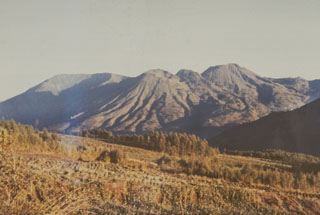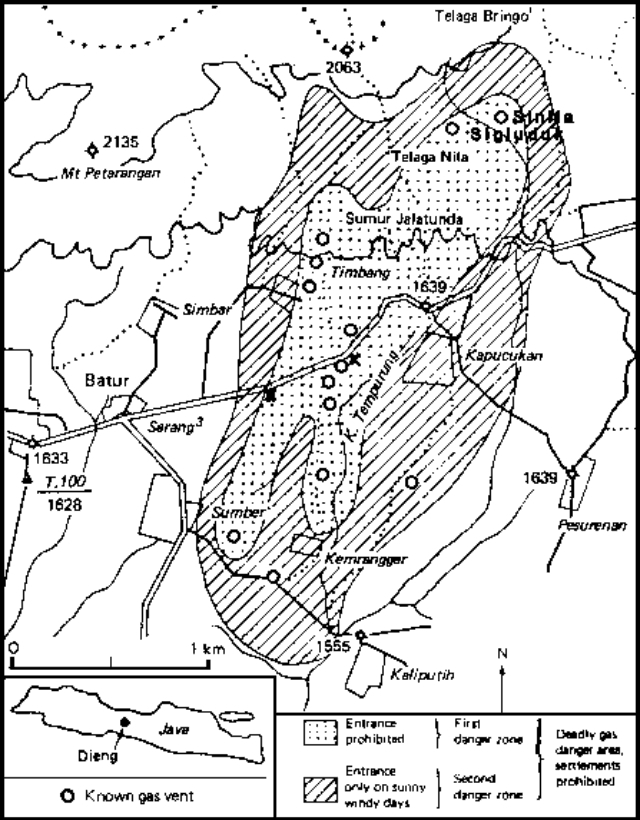Report on Dieng Volcanic Complex (Indonesia) — March 1979
Scientific Event Alert Network Bulletin, vol. 4, no. 3 (March 1979)
Managing Editor: David Squires.
Dieng Volcanic Complex (Indonesia) 149 killed by poisonous gas during 20 February eruption
Please cite this report as:
Global Volcanism Program, 1979. Report on Dieng Volcanic Complex (Indonesia) (Squires, D., ed.). Scientific Event Alert Network Bulletin, 4:3. Smithsonian Institution. https://doi.org/10.5479/si.GVP.SEAN197903-263200
Dieng Volcanic Complex
Indonesia
7.2°S, 109.879°E; summit elev. 2565 m
All times are local (unless otherwise noted)
The following information is compiled largely from interviews with Subroto Modjo, Chief of the Geothermal Section, Indonesian Directorate of Volcanology.
Poisonous gas emission, accompanying a phreatic eruption from the SW portion of the Dieng volcanic complex, killed 149 persons early on 20 February. Nearby residents felt earthquakes at 0155, 0240, and 0400, after which an explosion at 0504 ejected a dark gray cloud from Sinila Crater (figure 1), a small, water filled pre-existing vent. Less than 1 hour later, after the ejection of a second dark gray cloud, a hot lahar from Sinila flowed down a gully, cutting a road. At 0650, a new crater, named Sigluduk, opened 250 m W of Sinila and began emitting vapor. Sinila produced a second, larger lahar a few minutes later. The total volume of Sinila's two lahars was about 15,000 m3.
Residents of Koputjukan village fled the activity in several directions. Many of those who headed W towards Batur were killed by gas containing CO2 and H2S, emitted from many small vents and fissures S and W of the two craters, ponded in a low-lying area beside the road. Others were killed near an elementary school, to which they had retreated after observing the deaths along the Koputjukan-Batur road. Both areas had been known to emit poisonous gases in the past. Four rescue workers were also killed. About 15,000 were evacuated from six nearby villages, and two danger zones were delineated around the gas vents (figure 1); entry into the inner zone was completely prohibited, and use of the outer zone was limited to daylight hours.
Activity from the two explosion craters declined after ejection of a dark gray cloud from Sigluduk at 1100 on 20 February. By dawn the next day, Sinila was emitting dense white vapor, but only a little white vapor was escaping from Sigluduk. VSI personnel visited the craters early on the 22nd. Sinila's vapor emission had ended, although the bottom of the crater, 60-70 m across and 40 m deep, was filled with bubbling mud. Sigluduk, 25 m in diameter and 10 m deep, contained an active solfatara with a temperature of 71°C.
Further Reference. Le Guern, F., Tazieff, H., and Faivre Pierret, R., 1982, An example of health hazard: people killed by gas during a phreatic eruption: Dieng Plateau, Java, Indonesia: BV, v. 45, p. 153-156.
Geological Summary. The Dieng plateau in the highlands of central Java is renowned both for the variety of its volcanic scenery and as a sacred area housing Java's oldest Hindu temples, dating back to the 9th century CE. The Dieng Volcanic Complex consists of multiple stratovolcanoes and more than 20 small Pleistocene-to-Holocene craters and cones over a 6 x 14 km area. Prahu stratovolcano was truncated by a large Pleistocene caldera, which was subsequently filled by a series of cones, lava domes, and craters, many containing lakes. Lava flows cover much of the plateau, but observed activity has been restricted to minor phreatic eruptions. Gas emissions are a hazard at several craters and have caused fatalities. There are abundant thermal features and high heat flow across the area.
Information Contacts: S. Modjo, VSI; M. Krafft, Cernay; Kompas and Sinar Harapan, Jakarta.


